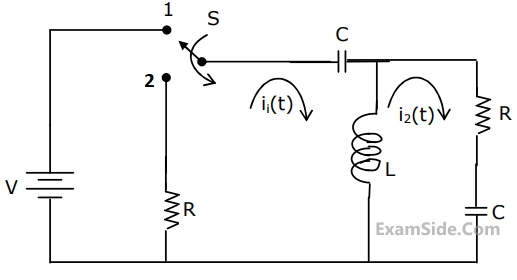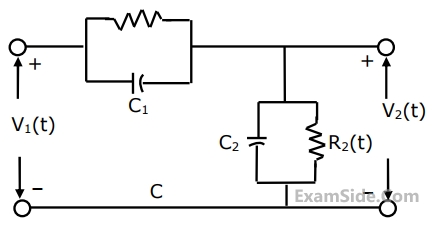1
GATE ECE 2003
MCQ (Single Correct Answer)
+2
-0.6
The circuit is given in figure.Assume that the switch S is in position 1 for a long time and thrown to position 2 at t = 0.

At t = 0+, the current i1 is
2
GATE ECE 2003
MCQ (Single Correct Answer)
+2
-0.6
The circuit is given in figure.Assume that the switch S is in position 1 for a long time and thrown to position 2 at t = 0.

I1(s) and I2(s) are the Laplace transforms of i1(t) and i2(t) respectively. The equations for the loop currents I1(s) and I2(s) for the circuit shown in figure, after the switch is brought from position 1 to position 2 at t = 0, are
3
GATE ECE 1996
MCQ (Single Correct Answer)
+2
-0.6
The voltage VC1, VC2 and VC3 across the capacitors in the circuit in Fig., under steady state, are respectively

4
GATE ECE 1992
MCQ (Single Correct Answer)
+2
-0.6
For the compensated attenuator of figure, the impulse response under the condition $$R_1C_1\;=\;R_2C_2$$ is:

Questions Asked from Transient Response (Marks 2)
Number in Brackets after Paper Indicates No. of Questions
GATE ECE 2023 (1)
GATE ECE 2018 (1)
GATE ECE 2017 Set 2 (1)
GATE ECE 2016 Set 2 (1)
GATE ECE 2016 Set 3 (1)
GATE ECE 2015 Set 2 (1)
GATE ECE 2015 Set 1 (1)
GATE ECE 2014 Set 4 (1)
GATE ECE 2014 Set 2 (1)
GATE ECE 2011 (1)
GATE ECE 2010 (1)
GATE ECE 2009 (2)
GATE ECE 2008 (3)
GATE ECE 2007 (1)
GATE ECE 2006 (2)
GATE ECE 2005 (1)
GATE ECE 2004 (1)
GATE ECE 2003 (2)
GATE ECE 1996 (1)
GATE ECE 1992 (1)
GATE ECE 1990 (1)
GATE ECE 1989 (1)
GATE ECE Subjects
Signals and Systems
Representation of Continuous Time Signal Fourier Series Discrete Time Signal Fourier Series Fourier Transform Discrete Time Signal Z Transform Continuous Time Linear Invariant System Transmission of Signal Through Continuous Time LTI Systems Discrete Time Linear Time Invariant Systems Sampling Continuous Time Signal Laplace Transform Discrete Fourier Transform and Fast Fourier Transform Transmission of Signal Through Discrete Time Lti Systems Miscellaneous Fourier Transform
Network Theory
Control Systems
Digital Circuits
General Aptitude
Electronic Devices and VLSI
Analog Circuits
Engineering Mathematics
Microprocessors
Communications
Electromagnetics



